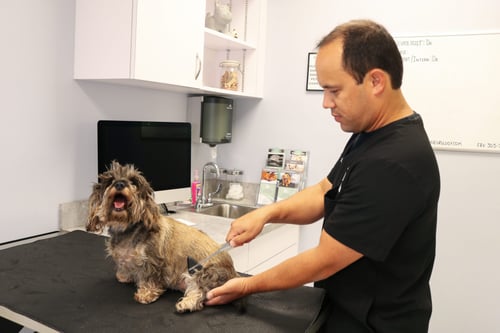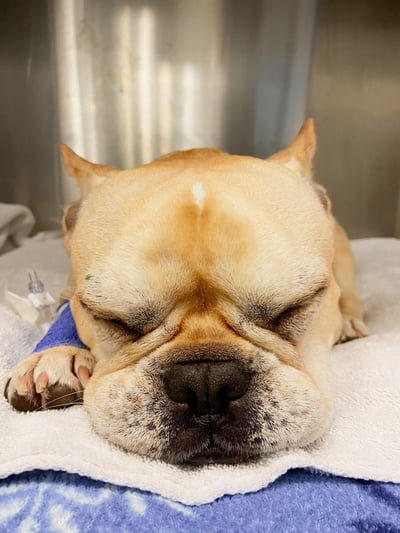What to Do When Your Dog Has a Seizure
Seizures are one of the most common neurological problems we see in veterinary neurology. Still, there are few things more agonizing than witnessing your dog having one. Although you may feel powerless, the best thing you can do for your dog in that moment is stay calm. Knowing what to do when your dog has a seizure can help.

What Are Seizures in Dogs?
Dog seizures are abnormal and unusually strong bursts of electrical activity in the cerebral cortex (the front part of the brain). What seizures tell us is that there is a problem with the brain. Unfortunately, they don’t tell us what that problem is. Seizures in dogs are actually just symptoms of another condition.
Why Does Your Dog Have Seizures?
There are many reasons why your dog can have a seizure, but there are three main categories:
REACTIVE SEIZURES
Seizures can result from a problem happening outside of the brain that is secondarily affecting the brain. Extracranial causes of seizures include metabolic disturbances such as low blood sugar, severe kidney or liver disease, electrolyte abnormalities such as low calcium, and exposure to toxins.
SYMPTOMATIC SEIZURES
Seizures can result from a problem happening inside of the brain. Intracranial causes of seizures include structural abnormalities such as inflammation, brain tumors, strokes, congenital malformations, brain infections, and head trauma.
IDIOPATHIC SEIZURES
It is also possible for seizures to have no identifiable cause. In fact, idiopathic epilepsy is the most common cause of seizures in dogs. Epilepsy may be genetic, with the first seizure usually occurring between six months and six years of age, though it can occur in both juvenile and geriatric patients. Idiopathic epilepsy is most frequently characterized by generalized tonic-clonic or grand mal seizures (whole body seizures), a normal exam, and everything else remaining normal between seizures.

How Do You Know When Your Dog Has a Seizure?
In a classic generalized seizure, all four limbs become stiff, and the animal falls over before convulsing. In partial or focal seizures, the pet will typically remain conscious and may only have abnormal movements of a single body part, like one limb or even just an ear.
The most common signs your dog is having a seizure are:
- Stiffening
- Collapsing
- Vocalizing
- Salivating
- Jaw clenching
- Muscle twitching
- Jerking body movements
- Paddling motions of limbs
- Chomping or tongue chewing
- Foaming at the mouth
- Loss of consciousness
- Involuntary defecating or urinating
Your dog may even start showing signs before a seizure begins. Many dogs will become anxious, clingy, unsteady, or dazed ahead of a seizure and remain wobbly, disoriented, temporarily blind, or try to hide afterwards.

What to Do When Your Dog Has a Seizure
Dog seizures are not painful, despite the frightening display. It may seem counterintuitive, but please AVOID restraining your dog during an episode, and keep your hands away from its mouth. Touching your dog will not provide any relief in the moment or change the outcome, and there is a high chance you will be bitten accidentally. Most seizures are self-limiting and will stop after about 30 seconds to a minute.
That said, here are some things to do when your dog has a seizure:
- Keep your dog from falling off furniture or down stairs
- Make sure your dog can’t hurt itself on anything in the area
- Note how long the seizure lasts
- Take a video if possible
- Contact your veterinarian
You do not need to call your veterinarian every time your dog has a seizure, but when your dog has a seizure for the first time or begins having seizures more frequently than usual, you should definitely contact your veterinarian.
However, it is considered an EMERGENCY if a seizure lasts more than three minutes, if your dog has more than two seizures in 24 hours, or if you think your dog has been poisoned. Get your dog to a veterinary facility immediately. DO NOT wait for a seizure lasting more than three minutes to end. The longer a seizure lasts, the higher the risk for serious and possibly fatal complications.
When Your Dog Should See a Veterinary Neurologist
The bottom line is that seizures in dogs are symptoms of a bigger problem. A veterinary neurologist will be able to pinpoint the root cause of your dog’s seizures in order to determine the most effective treatment plan. This is going to lead to the best possible outcome for your dog – and you.
If you have any questions or need any help with what to do when your dog has a seizure, compassionate experts at Southeast Veterinary Neurology are standing by for you and your furry family members, 24 hours a day, seven days a week. Call any of our locations in Miami, FL, Boynton Beach, FL, Jupiter, FL or Virginia Beach, VA. Reach out today!